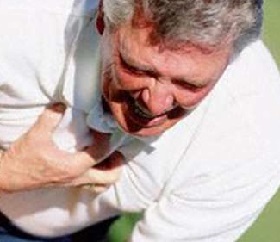 Cardiac asthma is acute left ventricular failure, which is caused by stagnation of blood in a small circle of circulation, as well as by international lung edema.
Cardiac asthma is acute left ventricular failure, which is caused by stagnation of blood in a small circle of circulation, as well as by international lung edema.
This manifestation is caused by attacks of suffocation, dyspnea, and also requires immediate medical attention, since even preliminary symptoms of cardiac asthma without proper treatment can lead to death.
The patient, who developed an attack, must be hospitalized in the hospital, even if he managed to stop before the ambulance arrived. The hospital will determine the cause of the attack and the treatment is prescribed.
It is inadmissible to self-medicate, treat folk methods, and also unauthorized violation of prescriptions of a doctor, as this can lead to repeated attacks, and even death.
What is it: the causes of cardiac asthma
In contrast to bronchial asthma, which develops because of the edema of the respiratory organs due to ingestion of the allergen, cardiac asthma leads to acute left ventricular failure. As a result, the blood plasma penetrates into the lungs, causing puffiness in these tissues, which means difficulty breathing and suffocation.
TOcommon causescan include the development of the following diseases:
- arrhythmia or ventricular tachycardia;
- cardiomyopathy in various manifestations:
- ischemic disease and other disorders of myocardial blood flow;
- endocarditis;
- infarct and pre-infarction;
- myocarditis;
- hypertension, with a special risk arises from a sudden change in pressure;
- aneurysm separation.
Given that most of these diseases a person acquires with age, we can say that the cardiac asthma leads to an unhealthy image life, namely, low mobility, malnutrition, obesity, bad habits and other factors contributing to the development of cardiac pathologies.
What is the difference between cardiac asthma and bronchial asthma?
The difference between bronchial asthma and cardiac asthma is that if in the first case the cause of dyspnea is bronchospasm and swelling their mucous membranes, in the second case, dyspnea is a consequence of inefficient operation of the pumping function of the heart.
For bronchial asthma, there is a preliminary contact with irritants, lung diseases, various allergic diseases. Bronchial asthma is always an independent disease, and cardiac asthma is one of the signs of heart failure.
Symptoms of cardiac asthma
 In the vast majority of cases, symptoms of cardiac asthma develop at night or in those cases when the patient is in a horizontal position.
In the vast majority of cases, symptoms of cardiac asthma develop at night or in those cases when the patient is in a horizontal position.
Severe suffocation is often accompanied by fear of death, and shallow and shallow breathing provokes the onset of psychomotor agitation.
In the case of cardiac asthma, the description of the classic symptoms is reduced to the following picture:
- patients wake up because of a feeling of lack of air.
- the position of the body is often forced, the patients sit with their hands on the edge of the bed.
- skin is pale, have a bluish shade.
- breathing is superficial, rapid, with difficulty in inhaling, dry wheezes are heard in the lungs.
- The arterial pressure at the beginning of an attack rises, and then, as a rule, decreases.
- the course of the process is aggravated by the psychological state of a person who, from a sudden feeling of suffocation, may panic, which makes breathing more difficult.
During the day, cardiac asthma usually worsens due to physical or emotional stress, increased blood pressure, or due to an attack of angina pectoris. The attack can provoke abundant food or drink. The attack is preceded by a feeling of tightness in the chest and a change in the heartbeat.
Dangerous symptoms of cardiac asthma are:
- appearance in the patient of distinct bubbling rattles, which can be heard even at a considerable distance from it;
- cold sticky sweat;
- blueing of the face (most pronounced in the nasolabial triangle) and limbs.
The appearance of such symptoms indicates the initial stage of pulmonary edema - an extremely life-threatening condition.
Cardiac asthma and pulmonary edema
A prolonged attack of cardiac asthma can be complicated by pulmonary edema. In this case, the pressure increase in the left atrium, vessels and capillaries is more than 28-30 mm Hg, which causes the transudation of the liquid part of the blood from the vessels into the alveoli (alveolar edema of the lungs). If hypertension of the small circle of circulation exists for a long time against the background of CHF, then in the capillaries there are significant morphological changes with deterioration of penetration. In such cases, even with significant arterial hypertension, pulmonary edema does not develop.
With pulmonary edema, the intensity of suffocation increases. There is a bubbling breath with a frequency of 40 or more per minute, from the mouth and nose begins to stand out foamy pink sputum, a sick nervous, restless, sitting in bed.
Cyanosis of the mucous membranes increases, there is increased humidity (cold sweat), swelling of the cervical veins. With a detailed clinical picture of the edema throughout the lungs, variously moist wheezing, sometimes in combination with dry ones, which are audible at a distance (a symptom of a "boiling samovar"). In the most severe cases, pulmonary edema occurs with hypotension and other symptoms of shock.
Treatment of cardiac asthma
Cardiac asthma treatment requires hospitalization, and it should be started when the first symptoms of an attack occur. The measures are aimed at relieving nervous tension, facilitating the work of the heart, eliminating the excitation of the respiratory center, preventing pulmonary edema.
Emergency care for a patient with cardiac asthma should be aimed at improving the activity of the weakened heart and lowering the excitability of the respiratory center. Treatment should begin with the introduction of 1 ml of a 1% solution of morphine or 1 ml of 2% pantopone in order to calm the overexcited respiratory center. The sedative of the latter is pipolfen, which is injected under the skin in an amount of 1 ml of a 2.5% solution in addition to the aforementioned drugs.
Following the morphine or pantopone to the destination and under the supervision of a doctor, you can apply a potent heart drug, the best strophanthin in the amount of 0.00025 (which is half the ampoule of the drug); Instead of strophanthin, you can enter the contents of the ampoule (0.0006) of the corglicon. Any of these drugs is injected into the vein (slowly!) With 10-15 ml of saline or glucose.
During the provision of medical care at home and in the hospital, the patient's blood pressure is constantly monitored. It is extremely prudent to be with the elderly. It is also necessary to take into account that the body of many may not perceive these or other medications.
Only qualified specialists should treat the disease, choosing the right preparations and calculating doses to eliminate its signs and consequences.
Nutrition and daily routine
The patient's day regimen is aimed at the prevention of repeated attacks of cardiac asthma.
- organization of the correct daily routine with a sufficient night sleep (not less than 8 hours) and rest during the day
- moderate exercise helps improve blood circulation in, as well as the normalization of the work of the respiratory center.
- recommended walking, exercise bike, swimming at an average pace, breathing exercises daily.
- daily walks in the fresh air improve the work of the heart and lungs.
- the elimination of stress, the restriction of significant physical exertion.
- avoid hypothermia, because colds can cause the development of cardiac asthma.
- quit smoking and alcohol abuse.
- regularly monitor blood pressure.
Drug treatment and diet are prescribed by the doctor individually in each case.
Forecast
Without the provision of medical care, the prognosis may be unfavorable, since there is a high probability of the transition of cardiac asthma into pulmonary edema, which can lead to death.
With successful arrest of the attack and regular intake of drugs prescribed for the underlying disease in order to reduce the progression of venous stasis in the lungs, the prognosis is favorable.

How to choose probiotics for the intestine: a list of drugs.

Effective and inexpensive cough syrups for children and adults.

Modern non-steroidal anti-inflammatory drugs.

Review of tablets from the increased pressure of the new generation.
 Antiviral drugs are inexpensive and effective.
Antiviral drugs are inexpensive and effective.


